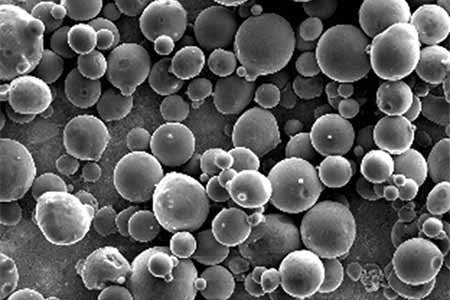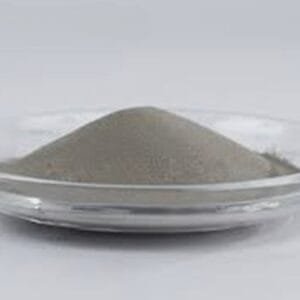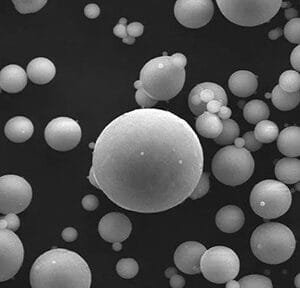Iron Powder
Iron powder is a critical material in powder metallurgy, representing about 85% of the total metal powder used. It is predominantly utilized in the production of machine parts due to its key properties.
Iron-based alloy powders are essential for creating abrasion-resistant and corrosion-resistant components. They are used in parts such as hydraulic turbine blades, nozzles, wearing rings, and hydraulic rods. Stainless steel powders, which are known for their excellent sphericity, low oxygen content, high hardness, and good toughness, are also widely employed.
Proper storage of iron powder is crucial to maintaining its quality. It should be kept in a cool, dry, and well-ventilated area, away from fire and heat sources, with relative humidity not exceeding 75%. The packaging must be sealed to prevent moisture exposure, and the powder should be kept separate from alkalis and alcohols. It is important to avoid storing it in mixed reservoirs, and the storage area should be equipped to handle any potential leaks.
For purchasing iron powder, TFM provides a variety of high-purity iron metal powders. If you do not find the specific sizes or compositions you need, please contact us by email. We offer customized options to meet your precise requirements.
Iron Metal powder
| Grade | Product Name | Chemical Composition | Particle Size | Apparent Density (g/cm3) |
|---|---|---|---|---|
| Fe-1 | Iron powder | Fe: ≥ 99.0% Other: ≤ 1.0% | -200 mesh customed sizes avaliable | – |
| Fe-2 | Iron powder | Fe: ≥ 99.0% Other: ≤ 1.0% | 2- 4 um, D50: 18-27 um customized sizes avaliable | 0.5-15 |
Spherical Iron Based Alloy Powder
Iron powder is a vital component in powder metallurgy, comprising approximately 85% of the total metal powder used. It is primarily employed in the manufacture of machine parts due to its essential properties.
Iron-based alloy powders are utilized in the production of abrasion-resistant and corrosion-resistant parts. These include hydraulic turbine blades, nozzles, wearing rings, and hydraulic rods. Stainless steel powders, known for their excellent sphericity, low oxygen content, high hardness, and good toughness, are also widely used in various applications.
TFM offers a range of high-purity iron-based alloy powders. If you do not find the specific sizes or compositions you need, please contact us via email. We can provide customized sizes and compositions to meet your requirements.
Grade:
Stainless steel powder: 304, 316L, 410L, 15-5PH, 17-4PH, 2Cr13
High-strength steel powder: A100, 300M, 30CrMnSiA, 40CrMnSiMoVA
Tool steel powder: 18Ni300, H13, M2, M35, M42, T15, 2030, S390
Iron-nickel alloy powder: Invar 36
Standard: GB/T 3077, GB/T 1299, GB/T 1480, GB/T 5329, GB/T 8180
Particle Size: 0-20μm, 15-45μm, 15-53μm, 53-105μm, 53-150μm, 105-250μm
Shape: Spherical, Ψ0≥0.85
Appearance: Gray
3D Printing Application: SLM, LMD
Other Application: PM, MIN, HIP, SP, Welding repair
Package: Vacuum packaging (Aluminum foil bag) or argon-filled protective packaging (Aluminum bottle)
Chemical Composition of Iron Based Alloy Powder
| Grade | Chemical Composition (wt.%) | ||||||||||||||||
|---|---|---|---|---|---|---|---|---|---|---|---|---|---|---|---|---|---|
| C | Cr | Ni | Mn | Mo | Si | Nb | Cu | Co | Ti | Al | V | P | O | N | S | Fe | |
| 304 | ≤0.07 | 17-19 | 8-10 | ≤2 | ≤1 | ≤0.035 | ≤0.03 | Bal. | |||||||||
| 304L | ≤0.03 | 18-20 | 8-10 | ≤2 | ≤1 | ≤0.035 | ≤0.03 | Bal. | |||||||||
| 316 | ≤0.08 | 16-18.50 | 10-14 | ≤2 | 2-3 | ≤1 | ≤0.035 | ≤0.03 | Bal. | ||||||||
| 316L | ≤0.03 | 16-18 | 12-15 | ≤2 | 2-3 | ≤1 | ≤0.035 | ≤0.03 | Bal. | ||||||||
| 410 | ≤0.15 | 11.5-13.5 | ≤1 | ≤1 | ≤0.035 | ≤0.03 | Bal. | ||||||||||
| 420 | 1.06-0.25 | 12-14 | ≤1 | ≤1 | ≤0.035 | ≤0.03 | Bal. | ||||||||||
| 430 | ≤0.12 | 16-18 | ≤0.6 | ≤1 | ≤0.75 | ≤0.04 | ≤0.04 | Bal. | |||||||||
| 630 | ≤0.07 | 15.5-17.5 | 6.5-7.5 | ≤1 | ≤1 | 0.15-0.45 | 3-5 | ≤0.035 | ≤0.03 | Bal. | |||||||
| 17-4PH | ≤0.07 | 15.5-17.5 | 3-5 | ≤1 | ≤1 | 0.15-0.45 | 3-5 | ≤0.035 | ≤0.03 | Bal. | |||||||
| 15-5PH | ≤0.07 | 14-15.5 | ≤1 | ≤1 | 0.15-0.45 | 2.5-4.5 | ≤0.04 | ≤0.05 | 3.5-5.5 | ≤0.03 | Bal. | ||||||
| 2Cr13 | 0.16-0.25 | 12-14 | ≤1 | ≤1 | ≤0.035 | ≤0.05 | ≤0.6 | ≤0.03 | Bal. | ||||||||
| SCM415 | 0.13-0.18 | 0.9-1.2 | 0.6-0.85 | 0.15-0.3 | 0.15-0.35 | ≤0.04 | ≤0.03 | Bal. | |||||||||
| S301 | ≤0.15 | 16-18 | 6-8 | ≤2 | ≤1 | ≤0.045 | ≤0.05 | ≤0.1 | ≤0.03 | Bal. | |||||||
| S310 | ≤0.08 | 24-26 | 19-22 | ≤2 | ≤1.5 | ≤0.045 | ≤0.05 | ≤0.03 | Bal. | ||||||||
| S220 | ≤0.03 | 22-23 | 4.5-6.5 | ≤2 | 3-3.5 | ≤1 | ≤0.03 | ≤0.05 | 0.14-0.2 | ≤0.02 | Bal. | ||||||
| 18Ni300 | ≤0.03 | ≤0.3 | 17-19 | ≤0.1 | 4.5-5.2 | ≤0.1 | 8.5-9.5 | 0.6-0.8 | 0.05-0.15 | ≤0.01 | ≤0.05 | ≤0.01 | Bal. | ||||
| H13 | 0.32-0.45 | 4.75-5.5 | 0.2-0.5 | 1.1-1.75 | 0.8-1.2 | 0.8-1.2 | ≤0.03 | ≤0.05 | ≤0.03 | Bal. | |||||||
| 1.2709 | ≤0.03 | ≤0.25 | 17-19 | ≤0.15 | 4.5-5.2 | ≤0.41 | 8.5-10 | 0.8-1.2 | ≤0.01 | ≤0.05 | ≤0.01 | Bal. | |||||
Self-fusing Iron Base Alloy Powder
Products Series
| Grade | Hardness (HRC) | Chemical Composition | Particle (mesh) | Application | ||||||||||
|---|---|---|---|---|---|---|---|---|---|---|---|---|---|---|
| C | Cr | Si | Fe | Mo | Ni | Mn | B | Other | ||||||
| Fe1 | 35-40 | 0.15 | 22 | 4.5 | Bal. | 2 | 13 | 1.6 | 100/270 | Valve | ||||
| Fe2 | 38-44 | 0.15 | 22 | 4.5 | Bal. | 2 | 10 | 1.8 | 100/270 | Valve seat | ||||
| Fe5 | 62-67 | 4.5 | 40 | 1 | Bal. | 0.97 | 1.8 | 100/270 | Drilling pipe joint | |||||
| Fe90 | 50-55 | 0.15 | 13.5 | 1.3 | Bal. | 1.6 | 100/270 | Drilling pipe joint | ||||||
| Fe6 | 58-60 | 0.8 | 7.5 | 2 | Bal. | 32 | 4 | 100/270 | Fan blades | |||||
| Fe45 | 40-46 | 0.6 | 7.5 | 2 | Bal. | 22 | 3 | 100/270 | Paper-making machines | |||||
| Fe304 | HB190 | 0.03 | 18 | 0.1 | Bal. | 10 | 0.3 | 100/270 | Paper-making machines | |||||
| Fe316L | HB190 | 0.03 | 17 | 0.2 | Bal. | 2.5 | 12 | 0.5 | 100/270、300/500 | Paper-making machines | ||||
| Fe410L | HB220 | 0.03 | 12.5 | 0.5 | Bal. | 0.1 | 100/270、 300/500 | Pistons | ||||||
| JG-1 | 19 | 0.03 | 17 | 0.8 | Bal. | 0.3 | 1.3 | Pistons | ||||||
| JG-2 | 26 | 0.04 | 17 | 0.3 | Bal. | 0.2 | 2.6 | Pistons | ||||||
| JG-3 | 46 | 0.12 | 16.5 | 0.8 | Bal. | 0.9 | Pistons | |||||||
| JG-4 | 63 | 1 | 4 | 0.3 | Bal. | 5 | 0.3 | Pistons | ||||||
| Fe253 | 35 | 1.75 | 28 | 1.3 | Bal. | 4.5 | 16 | 0.8 | 100/270 | Engine Valve | ||||
| Fe253H | 40 | 2.1 | 28 | 1.2 | Bal. | 5.5 | 11.5 | 1 | 100/270 | Engine Valve | ||||
| Fe101 | 62 | 3.3 | 2 | 1 | Bal. | 5 | 1 | 1.4 | 20/300 | Extrusion barrels | ||||
| Fe102 | 62 | 2.7 | 2.8 | 1 | Bal. | 5.5 | 1 | 1.9 | 20/300 | Extrusion barrels | ||||
| Fe103 | 62 | 1.5 | 4.5 | 1 | Bal. | 7 | 1 | 2.9 | W:4.5 | 20/300 | Extrusion barrels | |||
| Fe104 | 60 | 1.7 | 4.5 | 1.5 | Bal. | 11 | 0.8 | 3 | 20/300 | Extrusion barrels | ||||
| Fe105 | 62 | 1.5 | 4.5 | 1.3 | Bal. | 1.5 | 12 | 1 | 2.8 | 20/300 | Extrusion barrels | |||
| Fe106 | 62 | 1.08 | 5.42 | 2.01 | Bal. | 27 | 0.89 | 3.08 | 20/300 | Extrusion barrels | ||||
| Fe107 | 62 | 1.36 | 6.25 | 1.56 | Bal. | 16.2 | 1.02 | 2.98 | 20/300 | Extrusion barrels | ||||





Reviews
There are no reviews yet.